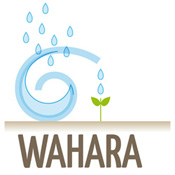What is Water Harvesting?
- Details
- Created on Thursday, 18 August 2011 09:44
- Written by Erik van den Elsen
Water and its importance in agriculture
Water is essential to all life – human, animal and vegetation. It is therefore important that adequate supplies of water be developed to sustain such life. Development of water supplies should, however, be undertaken in such a way as to preserve the hydrological balance and the biological functions of all ecosystems. This is crucial for marginal lands, like in many areas of Africa.
Consequently, the human endeavour in the development of water sources must be within the capacity of nature to replenish and to sustain. If this is not done, costly mistakes can occur with serious consequences. The application of innovative technologies and the improvement of indigenous ones should therefore include management of the water sources to ensure sustainability and to safeguard the sources against pollution.
As land pressure rises, more and more marginal areas in the world are being used for agriculture. Much of this land is located in the arid or semi-arid belts where rainfall is irregular and much of the precious water is soon lost as surface runoff. Recent droughts have highlighted the risks to human beings and livestock, which occur when rains falter or fail. While irrigation may be the most obvious response to drought, it has proved costly and can only benefit a fortunate few. There is now increasing interest in the low cost alternative, generally referred to as ‘water harvesting’.
Definition of Rainwater Harvesting
Rainwater harvesting is defined as a method for inducing, collecting, storing and conserving local surface runoff for agriculture in arid and semi-arid regions (Boers and Ben-Asher, 1982). Rainfall has four facets. Rainfall induces surface flow on the runoff area. At the lower end of the slope, runoff collects in the basin area, where a major portion infiltrates and is stored in the root zone. After infiltration has ceased, then follows the conservation of the stored soil water.
Water Harvesting examples
Example of water harvesting using Stone Lines
Stone lines or ("bunds") slow down runoff and increase water infiltration to improve production in semi-arid areas. At the same time, sediment is captured behind these semi-permeable barriers. Stone lines were originally a traditional technique in the Sahel, but have been improved by careful construction, and through aligning them onto the contours of the land.
A perennial grass (Andropogon guyanus) is sometimes planted to supplement the lines where stone is scarce. Stone lines are suited to low slopes, high runoff and hand labour. This technique is readily adopted by resource-poor farmers and can lead to a harvest even in years with low and erratic rainfall. Wide and deep planting pits (called 'zai' in Burkina Faso; 'tassa' in Niger) are often used in combination, acting as microcatchments within the field.
[Source: www.iied.org]
Example of water harvesting using Fanya Juu Terraces
Fanya juu ("throw the soil up" in Kiswahili) terraces are the most popular and successful cross-slop barrier measures used in Kenya's small scale farming sector. Contour earth bunds are constructed by throwing soil upwards from trenches immediately below them. This design leads to the gradual formation of terraces with a level or slightly forward sloping bed.
This is a very versatile technology - ideally suited to smallholder farms, especially in sub-humid areas where the land is sloping and erosion a threat. Fodder grasses may be planted on the bunds and fed to livestock. In the dry areas, water harvesting from roads into the trenches allows production of bananas and fruits. This is a proven and effective adaptation technology in the highlands of East Africa and beyond.
[Source: www.iied.org]
